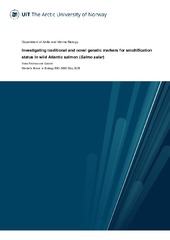Investigating traditional and novel genetic markers for smoltification status in wild Atlantic salmon (Salmo salar)
Author
Løvold, Vera AndreassenAbstract
Atlantic salmon are anadromous fish, meaning they hatch and live their young lives in freshwater (FW), before migrating to seawater (SW) to feed and grow. The salmon must undergo physiological change to prepare for the new environment. This adaptation is called smoltification or parr-smolt-transformation (PST). One of the most obvious changes is the increasing salinity in SW. As the salmon migrates from FW to SW, it therefore needs to change its osmoregulatory strategy. The gill one of the main osmoregulatory organs, and during smoltification, the gill changes for ion-absorbing to ion-secreting. This change in direction of ion-flow is caused by a change in membrane proteins, namely cystic fibrosis transmembrane conductance regulator (CFTR) and Na+/K+-ATPase (NKA) a-subunit, in the gill mitochondria-rich cells (MRCs). Due to their known role in osmoregulation and known increase during smoltification, the mRNA expression, protein abundance and/or enzyme activity have been used as a marker for smoltification in the aquaculture industry. It is known in the aquaculture industry that the fish need to be exposed to a minimum of 6 weeks short photoperiod before subsequent transfer to long photoperiod to fully smoltify. It has therefore been proposed a set of novel genetic markers in the gill for smoltification, which have been shown to be dependent on photoperiodic history. To further investigate some of these genes, capn2, slc5a7 and Cuzd1, we took gill samples from parr and smolt in Repparfjord river in Finnmark during spring and summer, and quantified the relative genetic expression of a set of selected genes. We compared these with similar analysis of gill tissue from fish raised in a laboratory setting with a controlled exposure to photoperiod. We hypothesized that there would be a clear difference in genetic expression between parr and smolt, and further a difference between early smolt (spring) and migrating smolt (summer). We expect to see similar expression patterns in the gill samples from the laboratory fish. The results showed a clear distinction between parr and smolt, both from the field and from the lab. Interestingly, in the field, there was also a clear distinction between smolts from spring compared to both parr and summer smolt, which was not seen as clearly in the laboratory fish. The role of these novel markers in smoltification is not yet fully understood, but these findings suggest that there is a need for more research to fully understand smoltification in Atlantic salmon.
Publisher
UiT The Arctic University of NorwayMetadata
Show full item recordCollections
Copyright 2025 The Author(s)


 English
English norsk
norsk
